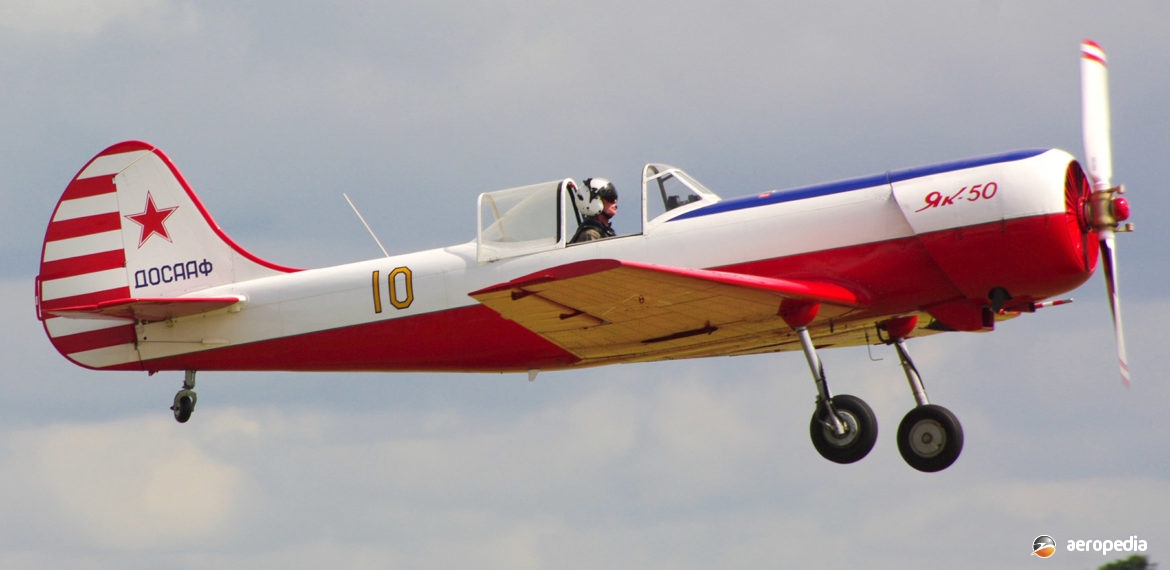Photograph:
Yakovlev Yak 50 ZK-YAC (c/n 822108) at Wanaka, New Zealand in April 1996 (David C Eyre)
Country of origin:
Union of Soviet Socialist Republics
Description:
Single-seat high-performance aerobatic monoplane
Power Plant:
One 269 kw (360 hp) Vedeneyev M-14P nine-cylinder supercharged air-cooled radial engine
Specifications:
- Wingspan: 9.50 m (31 ft 2 in)
- Length: 7.80 m (25 ft 7 in)
- Height: 3.2 m (10 ft 5 in)
- Wing area: 15.0 m² (161.5 sq ft)
- Never exceed speed: 450 km/h (280 mph)
- Max cruising speed: 400 km/h (249 mph)
- Economical cruising speed: 270 km/h (168 mph)
- Rate of climb: 959 m/min (3,145 ft/min)
- Service ceiling: 4,000 m (13,123 ft)
- Take-off roll: 100 m (328 ft)
- Landing roll: 250 m (820 ft)
- Fuel capacity: 118 litres (26 Imp gals)
- Range: 463 km (288 miles)
- Empty weight: 775 kg (1,709 lb)
- Useful load: 220 kg (485 lb)
- Loaded weight: 995 kg (2,194 lb)
History:
In 1937 Aleksandr Sergeyevich Yakovlev designed the Yak 10, an open cockpit two-seat training aircraft with a 90 kw (120 hp) Renault engine. This was later developed into the Yak 18, also a trainer but with tandem cockpits and a retractable undercarriage. The Yak 18A was developed by the Chinese State Factories into the CJ-5, and later the CJ-6. The Yak 50 was later designed and developed by Sergei Yakovlev, son of Aleksandr, and Yuri Yankevich, in the mid 1970s, but it differed from its predecessor in having all-metal construction, with a semi-monocoque fuselage and smaller overall dimensions. It had a smaller, lighter airframe, and a wing section designed to enhance inverted flight.
Making its first flight in 1975, and after a considerable amount of testing, it was placed in production at Arsenyiev in the Russian far-east, deliveries to flying clubs beginning that year. Unlike a number of other Soviet designed trainers, it was only built in relatively small numbers, production concluding in 1985 after 312 had been completed, and most were delivered to the Russian Air Force, eight to East Germany, and six to Bulgaria.
Due to major G-forces involved in competition aerobatics in the last 30 odd years a number of Yak 50s were flown at +11G and more. This led to four airframe failures. The manufacturer then introducing a series of airframe modifications to meet competition demands.
Variants of the M-14 series of engines available included the M-14P of 269 kw (360 hp), M-14PF providing 298 kw (400 hp), and the M-14R providing 336 kw (450 hp), driving a two-blade V-530 Russian propeller, but the German MTV-9-250 three-blade unit could also be installed. Fuel was contained in two tanks, one of 227 litres (50 Imp gals) for aerobatics, and a second of 341 litres (75 Imp gals) for cross country and ferry flights. Some have had two 75 litre (16.4 Imp gals) additional tanks built into the wings.
The Yak 50 was first seen in the 1976 World Aerobatic Competition when aircraft from the Yakovlev design bureau took the first three places in the men’s competition, and five of the top ten positions in the women’s competition, as well as taking the overall men’s and women’s team prizes. At that stage competition for the new type came from types such as the Zlin 50 and Pitts Special. One of the new breed of aerobatic competition aircraft to come out of the old Soviet Union, it was described as charismatic, a delight to fly, had good performance and was affordable to operate.
When the Yak 55 was introduced into service all Russian training units equipped with the Yak 50 were ordered to deliver the aircraft with their log books to Moscow, where most were scrapped. Since then the survivors have become popular in the west and it is believed about 60 survive.
Typical of Eastern Bloc aircraft, compressed air was used for engine starting via a main pneumatics reservoir, this also powering flaps, undercarriage and brakes, an engine driven pump keeping the reservoir topped up. Similar in configuration to the Yak 52, the Yak 50 had a tailwheel undercarriage with a fixed tailwheel and main legs hinged close to the wing leading-edge to fold backwards, leaving the wheels and legs semi-exposed when retracted. The fuselage was semi-monocoque and the single-spar wing was built in two main panels attached directly to the fuselage without a center section. The first examples seen in the west were imported to the United Kingdom where they were sponsored by Vladivar and, with a 298 kw (400 hp) engine, a three-blade propeller and lightweight systems, were able to climb at 1,524 m (5,000 ft) per minute. Structural strength was +9/-7 G.
When first introduced the Yak 50 proved its ability by winning a number of aerobatic competitions and, although aging, it still proved its worth in competitions. The first example (44535) seen in Australia arrived in the 1980s when it was entered in the Phillips Aerobatic Challenge and was flown by world champion, Russian, Victor Smolin.
A number have been imported to this region, including ZK-YAC (c/n 852904 – ex G-BWCF, LY-ANQ) which was later exported to Australia as VH-YAY in June 1998; VH-YAX (c/n 832504 – ex DOSAAF -02) registered in July 1993; VH-YVO (c/n 842868 – ex RA-44535, DOSAAF-36) registered in July 2001; VH-NLY² (c/n 760802 ) registered in April 2006 and exported to Canada as C-FGRA in 2019; VH-YKL² (c/n 832509 – ex N509RA, RA-01358, ZU-ALM, RA-01358, DOSAAF-07) registered in March 2012; and VH-YKN² (c/n 822201 – ex DOSAAF-68) registered on 11 February 2013.

